Cool, Moist Springs, Aphids, and Lady Beetles: A cool, moist spring will be good for lady beetles, and other predators feeding on aphids. A single lady beetle larva will eat between 200-300 aphids before becoming an adult. As adults, females eat up to 500 aphids before laying eggs! Before applying any treatment sprays against aphids, monitor for predators and consider if the infested plants are in a key location. If not, then let natural predators provide control.
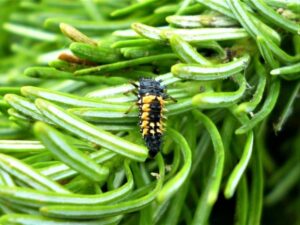
Species of lady bird beetle larva that specializes feeding on aphids. (Photo Credit: Steven K. Rettke, Rutgers Coop. Ext.)
Management of Aphids Using Soaps?: Although the use of insecticidal soap is stated to be a “biorational” pesticide and is recommended within IPM programs, research has indicated that they typically provide less than satisfactory controls against aphids within the landscape. Insecticidal soap is commercially available under the trade name M-PEDE and although aphids are included on the label, the research indicates only a 5% to 10% reduction of an aphid population with a single application when applied at label rates. The M-PEDE label indicates the less than satisfactory controls it achieves against aphids with a single application. Conversely, it is important to emphasize that insecticidal soap will provide outstanding efficacy against adelgids (i.e., spruce galls & hemlock woolly adelgids) and is highly recommended as a control material against these insects (Precautionary note: As similar to oils, some soap sprays may remove the blue coloration on conifers).
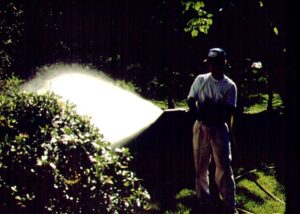
Both horticultural oil & insecticidal soap sprays require good coverage to provide effective controls. (Photo Credit: Steven K. Rettke, Rutgers Coop. Ext.)
This blog includes some of the common insect/mite pests often encountered in NJ landscapes during the month of April. They may require monitoring & intervention to prevent plant damage. Also some abiotic concerns & scouting tips are included. The insect/mite pests reviewed are native holly leaf miner, spongy moth, honey locust spider mite, honey locust plant bug, eastern tent caterpillar, southern red spider mite, hemlock woolly adelgid, & hemlock rust mite.
Native Holly Leaf Miner (Phytomyza ilicicola): Most of the feeding damage from these yellow, immature flies that tunnel through the leaves occurs during the early spring months. During the fall, the typical serpentine mines are narrow but are often greatly expanded during the spring by the overwintering larvae. Therefore, late March & April can be important times to apply controls to prevent this leaf miner’s most damaging stage. Two other possible control window opportunities are against the adults in May and smaller larvae in the fall season. The IPM approach dictates that no pesticides will be applied unless significant leaf-miner populations are present. Pull off and destroy mined leaves before May in light infestation on small hollies. Pesticide products include the translaminar materials acephate (Orthene), abamectin (Avid), and spinosad (Conserve) to control the larvae. Merit must be applied now as a soil drench. Place sticky traps out to monitor for adults. Contact insecticides such as Sevin (carbaryl) or any of the pyrethroids will only suppress the adults.
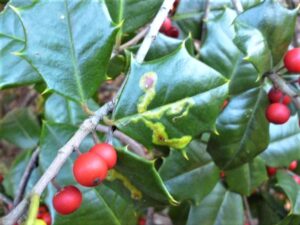
Native holly leafminer causes the most leaf damage during the early weeks of spring. (Photo Credit: Steven K. Rettke, Rutgers Coop. Ext.)
Home Remedies? Recommendations for homemade concoctions for pest control around the home should be viewed with suspicion. Blends of sugar, mouthwash, alcohol, and urine may not be of high enough concentrations to cause harm to plants (or benefit?). However, the Cooperative Extension’s stance is that we do not recommend homemade pest control products that have not been evaluated in replicated, scientifically designed experiments. Furthermore, the legal issues of recommending such products, or using them on someone else’s property, are also a factor, since such products must be registered, according to federal law.

It is illegal for commercial applicators to use home remedy cocktails as pesticides. (Photo Credit: Steven K. Rettke, Rutgers Coop. Ext.)
Estimating Spongy Moth Egg Counts (Lymantria dispar)(90-448 GDD = early instars): The counting of egg masses within an area the size of an acre is extremely difficult. A more practical plot size is needed when counting and estimating spongy moth populations at various locations. Performing counts within circular plots having a diameter of 37 feet (1/40th of an acre) greatly simplifies the procedure. Therefore, in residential areas, only 6 or 7 standard-sized egg masses counted within the 1/40th of an acre site will equal threshold levels. Within urban park settings, the threshold count can be higher with 13 egg masses per 1/40th of an acre plot. If standard-sized egg mass counts exceed 25 per 1/40th acre plot (e.g., 1000 egg masses per acre), then severe defoliation levels should be projected. When populations reach these density levels the use of B.t. (Bacillus thuringiensis) is no longer an effective control option and the use of standard chemical materials will be required. When estimating the potential spongy moth pressures within larger land areas, it is important to draw a random transit through the area and perform counts on more than only one 1/40th acre plot. For example, when dealing with a grove of oaks within a 50-acre park, at least 5 plots of 1/40th acre size will need to be counted. It may also be important to consider that the wood lot edges containing oaks will typically have higher spongy moth egg mass populations.
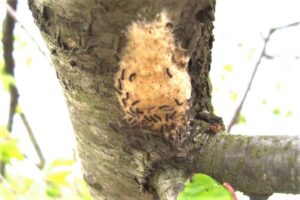
Spongy moth caterpillar egg hatch will occur in many areas of NJ during the month of April. (Photo Credit: Steven K. Rettke, Rutgers Coop. Ext.)
Drought vs. Frost Cracks: Many arborists and landscapers often suggest to their inquiring clients that frost cracks are the reason for the bark separation within the trunks of trees. Oftentimes, however, the actual cause may be drought stress. Drought cracks occur most commonly when trees are first planted and a year or so after transplant. The trunks will crack if trees are allowed to become too dry. Some common trees more susceptible to this condition include maple, honey locust, crabapple, mountain ash, and London plane.
One of the easiest ways to distinguish between drought vs. frost cracks is by the way the wounds close. Drought cracks typically represent a one-time event and will generally close or seal almost completely and never re-open again. On the other hand, frost cracks are more likely to continue to open and close over subsequent years. Usually, less freezing and thawing stress is required to re-open the crack in the future and the development of a conspicuous callus ridge often occurs over time.
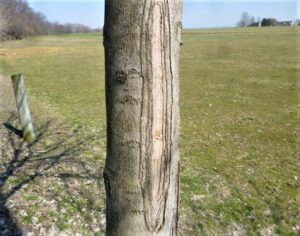
Drought cracks often occur to young transplants & then seal over & never open again. (Photo Credit: Steven K. Rettke, Rutgers Coop. Ext.)
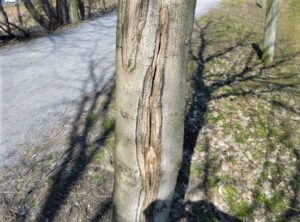
Frost cracks will often open & close repeatedly in subsequent years. They may never completely seal over & can easily reopen again multiple times. (Photo Credit: Steven K. Rettke, Rutgers Coop. Ext.)
Sunscald wounds occurring on the south or southwest sides of tree trunks can also create cracks (i.e., frost or drought cracks can occur on trunk sides facing any direction). Sunscald wounds generally never close or seal over and may often increase in size as the tree grows.
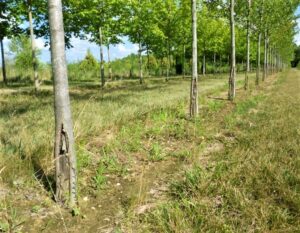
Sunscald cracks on red maples growing in a nursery. These cracks will typically occur on the southwest sides of trees. (Photo Credit: Steven K. Rettke, Rutgers Coop. Ext.)
Although there is rarely any need for immediate concern when managing trees with these types of trunk cracks, the open wounds can increase the potential exposure to wood decay fungi & wood-boring insects.
Honey Locust Spider Mite (Platytetranychus mutidigitali): This native spider mite feeds only on the leaves of honey locusts. The orange, overwintering adults are only 1/50 of an inch and can presently be found congregating in bud scars and bark cracks. Although this mite is typically classified as a warm-season mite, the eggs from the overwintering adults are laid in early spring and hatch shortly after bud break. There are multiple generations per year & by the beginning of summer, all stages can be seen on the plant. Generally, the honey locust mite can be found feeding on this tree all season long, although the greatest populations will accumulate during the summer months.
Examine trees with a history of this pest with a 10x-16x hand lens now. Look in bud scars and bark cracks to estimate future potential mite populations. During the later spring months, monitor the leaves for increasing amounts of stippling damage. Heavy infestations may cause foliage to brown and die. Re-foliation is common if damage occurs early in the season.
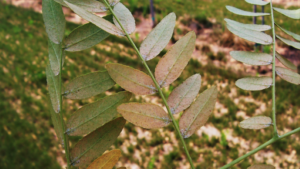
Honey locust spider mite overwintering eggs hatch soon after leaf emergence. White colored cast skins & egg shells will occur on undersides of leaflets. Photo Credit: Steven K. Rettke, Rutgers Coop. Ext.)
Dormant oil sprays (2-3%) can still be used if the leaf buds have not yet opened. Later in the spring, if the mite populations are showing signs of building up on the foliage, use a summer oil (1-2%) or soap. Hexythiazox (Hexygon), a biorational miticide is a mite growth regulator and is effective against only eggs and immature nymphs. Although it does not control adults, any eggs laid by adult females will be sterile. Other miticides that may be necessary during large population outbreaks include abamectin (Avid) and fluvalinate (Mavrik) as well as many others.
Honey Locust Plant Bug (Diaphnocoris chlorionis) (58-248 GDD = nymphs/adults): The 1/8-inch-long pale green nymphs resemble young leafhoppers and feed upon emerging foliage in the spring. During high populations, the stippling damage and stunted leaves become obvious, and defoliation typically occurs. Black fecal spots on the undersides of the leaves are similar to lace bug damage but may be more scattered over the surface. Even as late as June, both nymphs and adults are still active, but unless there is a large population, the tree usually will outgrow the damage and no action is necessary.
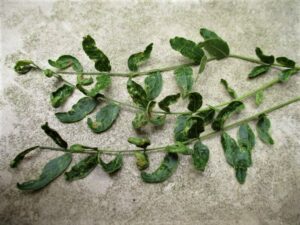
With their piecing-sucking mouthparts, honey locust plant bugs will stunt & disfigure foliage soon after emergence. (Photo Credit: Steven K. Rettke, Rutgers Coop. Ext.)
If controls are needed, using a 2% oil spray when adults are present will give good control. Use a threshold of one plant bug per compound leaf before spraying (to determine the number of bugs per leaf, knock a branch on a white paper attached to a clipboard and count the number of bugs per compound leaf). The reduced-risk material acetamiprid (Bonide Systemic) can provide effective controls against sucking insects.
Girdling Roots: Many tree species can develop potentially life-threatening girdling roots, but maple species as well as zelkova are notorious for developing them in the urban landscape. As offending girdling roots expand in diameter and press against the also expanding central stem, an inevitable slow decline of the tree begins. When two roots grow together or when two branches grow together they can share conducting tissues. However, root and stem tissues cannot graft together, and detrimental effects occur when they expand into one another.
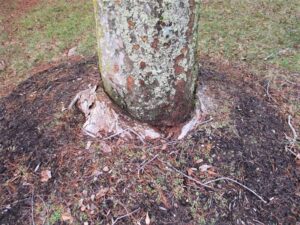
This zelkova was planted too deep & the resulting girdling roots will inevitably shorten the life of the tree. (Photo Credit: Steven K. Rettke, Rutgers Coop. Ext.)
Typically, the growth of the crown declines & leaves displays early fall colors, and twig/branch dieback becomes progressively pronounced. A common symptom that can be observed easily from a distance is when the tree trunk goes straight into the ground with no visible root flare. With valuable trees, the excavation and removal of offending roots may be considered. This management strategy is only suggested if the tree decline is not too advanced, and no more than a couple of major girdling roots are involved. One of the primary causes of girdling is when new transplants are planted too deep. The casual observation in wooded and forested areas indicates that girdling roots are rare at these sites.
IPM Scouting Fundamentals: Some commentary to consider for improving routine monitoring effectiveness: (1) – Make it a common practice to reverse directions each time you visit a specific property. It is surprising what may be observed when scouting in one direction that is completely overlooked when moving in the opposite direction. (2) – Scouting the same property at different times of the day can uncover possible problems that may be less obvious during a certain time of day. Shadows and sunlight angles change throughout the day which can mask or enhance plant symptoms or signs. (3) – Scouting during overcast days will typically provide ideal visual conditions. The subtle color variations of plant foliage are best observed without the sharp contrasting shadows from bright sunlight.
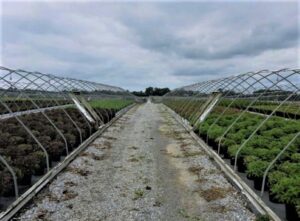
Scouting this nursery for pests on a cloudy day day will give best results. (Photo Credit: Steven K. Rettke, Rutgers Coop. Ext.)
Eastern Tent Caterpillar (Malacosoma americanum)(90-190 GDD = younger larvae treatment): During some years, observations along the I-195 and I-295 corridors can show evidence of expanding white webbings of the tents of this caterpillar. Newly hatched caterpillars feed on foliage and increase the size of their nest/tent as they grow. Unlike the spongy moth, this native caterpillar has never been a genuine threat to the health of our forests. The concern in the urban landscape is only aesthetic. It is found feeding primarily within crabapple and wild black cherry trees. The caterpillars are black and hairy, with a white stripe running down their back.
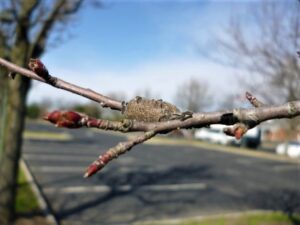
Photo shows eastern tent caterpillar 1st-instars just beginning to hatch. (Photo Credit: Steven K. Rettke, Rutgers Coop. Ext.)
Since they are still small, now is the best time to control them. Do not use flaming torches, but simply prune/rub out webs if they are within easy reach. Prune early in the morning/late afternoon or during rainy days when caterpillars are inside the nest. When the tents are still small the spraying of horticultural oil or B.t. (Bacillus thuringensis) insecticides can be effective. When using B.t. it is important to spray adjacent foliage, since the caterpillars must ingest the crystal toxins. Once larvae get large, they leave the tent to feed at night and hide during the day. Penetrate the nest and control with carbaryl (Sevin), Conserve, Orthene, or one of the pyrethroids.
Southern Red Spider Mite (Oligonychus ilicis)(69-157 = Egg hatch): Some of the early overwintering egg hatchings of these cool-season spider mites have commenced and may continue for another couple of weeks in the central sections of the state. The spruce spider mite that feeds on needle conifers often receives the most attention during the spring months, but the southern red mite can cause a great deal of aesthetic damage to broadleaf evergreens (especially Japanese Holly). Adults are purple-red, and the size of the period is at the end of this sentence. Look for white stippling damage on the foliage, particularly near the leaf midrib. Lower leaf surfaces often appear dusty because of the numerous eggshells and shed skins.
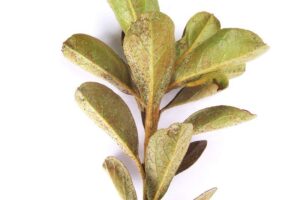
Southern red spider mites are a cool season species. Bright red eggs overwinter & hatch during the early weeks of spring. (Photo Credit: Steven K. Rettke, Rutgers Coop. Ext.)
If more than 10-15 mites can be knocked onto a beating tray/white paper, then control with horticultural oil or insecticidal soap. If more than 10% damage is evident, use Avid, Hexygon, Floramite, or one of the labeled pyrethroids. Especially when using pyrethroids, return monitoring visits are important to evaluate effectiveness since eggs are not killed, but native mite predators are. Typically, additional sprays will be required with high infestations. Adults will be active into June, “hibernate” during the summer heat and then resume activity in September.
Hemlock Woolly Adelgid (Adelges tsugae)(150 GDD = 10% egg hatch): Imidacloprid (Merit) applied as a soil injection or drench has been the material of choice for the past few decades to combat this pest. This approach is especially effective for the protection of taller hemlocks when foliar sprays may prove difficult. Since hemlock woolly adelgids (HWA) essentially never leave the host, imidacloprid (Merit) can be applied anytime during the year as long as the ground is not frozen and adequate soil moisture is present. It is usually best to make most applications during the spring or fall months. With large trees, it may require 6 to 8 weeks before sufficient concentrations of the active ingredient are translocated into the upper canopy.
When using horticultural oils or other labeled insecticides avoid making spray treatments this time of year (early spring). HWA eggs will not begin to hatch until late April or early May in the northern half of the state. At 150 GDD only about 10% egg hatch of the crawlers has occurred. At 350 GDD (mid-late May) only about 50% of egg hatch has occurred. Presently, most of the egg-laying females are already dead and the eggs are clumped tightly together within the protective white wooly wax. Although an oil or soap spray may destroy contacted crawlers and exposed outer eggs within the clumps, most of the unhatched eggs will not be affected. Egg hatching and crawler emergence can extend for 6 weeks or more. To avoid multiple sprays during the spring, it is more efficient to wait until early to mid-June after all of the eggs have hatched and the exposed, settled crawlers (which have a white fringe of wax circling their bodies) are all neatly lined-up at the base of leaf petioles. Being patient to apply sprays during this control window can save time and material and will be the most efficient.
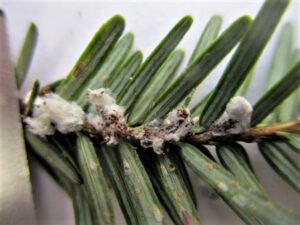
Hemlock woolly adelgid egg clusters hidden within the white woolly sacks. (Photo Credit: Steven K. Rettke, Rutgers Coop. Ext.)
Hemlock Rust Mites (Nalepella tsugifoliae)(7-22 GDD = egg hatch): Hemlock rust mites are cool or even cold-season mites that have been active for several weeks already. These mites are difficult to see without magnification. Use at least a 10x magnification (15x-20x would be better) to identify their light yellow, spindle-shaped forms. Adults overwinter in bark cracks of hemlocks (also spruce, fir, and yew) and start feeding on the needles during warm periods in March. They continue to feed in the months of April, May, and June. Needles turn off-color to a light yellowish green and may drop by midsummer. Their numerous thin, white, shed skins may be noticed, scattered around both sides of the hemlock needles.
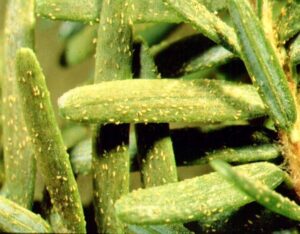
Hemlock rust mites are a cold season species & can begin activity during March in NJ. (Photo Credit: Ohio State Coop. Ext.)
Although hemlock rust mites may be active up to early summer, most of the damage usually occurs in the spring. A useful monitoring technique is to inspect the south side of hemlocks in April and May for light-yellow foliage. When mite populations are high, control with horticultural oil at the first sign of activity.

